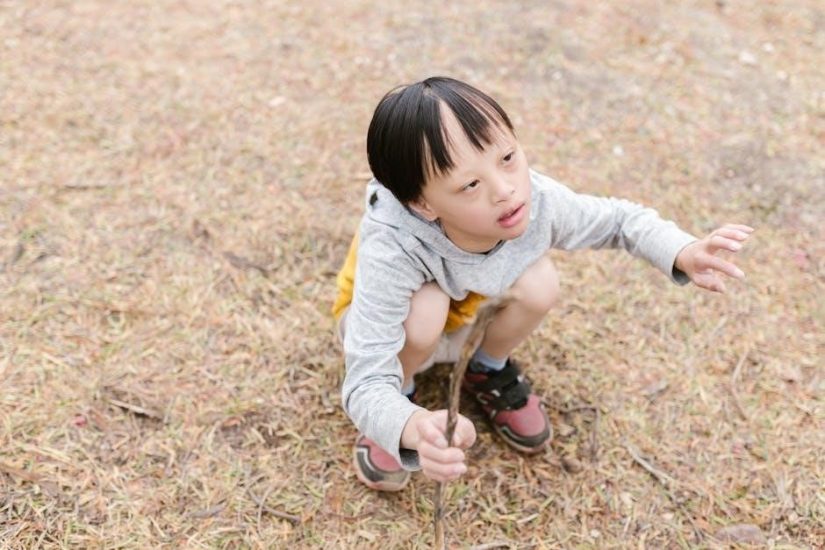Physical development activities for 3-5 year olds are essential for enhancing gross and fine motor skills, promoting coordination, balance, and creativity through play and overall well-being.
Understanding the Importance of Physical Development in Early Childhood
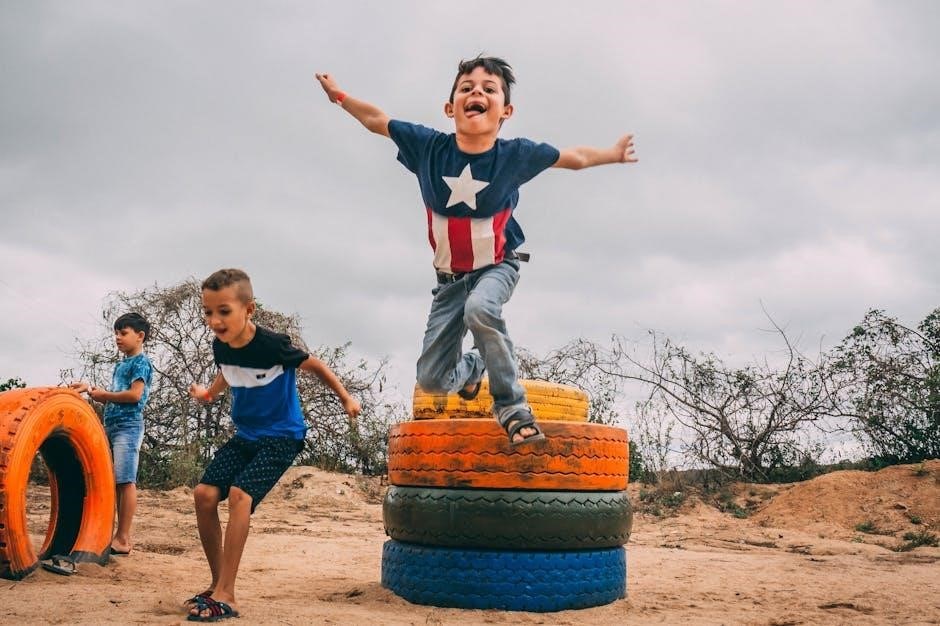
Physical development in early childhood is crucial for building strength, coordination, and motor skills. It enhances creativity and supports emotional well-being while fostering independence and social interactions. Regular physical activities help children develop essential muscles, refine balance, and improve endurance. For 3-5 year olds, at least 60 minutes of moderate to vigorous physical activity daily is recommended. Play-based exercises, such as ball games, running, and indoor obstacle courses, are effective in promoting overall growth and skill mastery during these formative years.
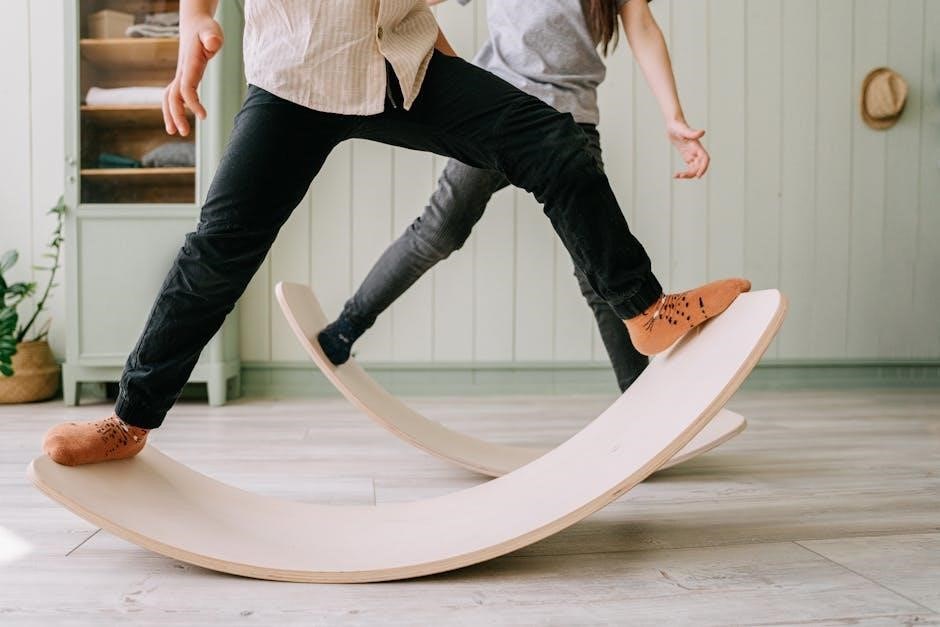
Age-Appropriate Physical Activities for 3-5 Year Olds
Age-appropriate physical activities for 3-5 year olds include running, jumping, hopping, and ball games, which enhance gross motor skills. Indoor obstacle courses, dance parties, and balancing exercises are ideal for refining coordination. Outdoor play, such as tag, cycling, and exploring nature, promotes endurance and creativity. Activities like water play, using ribbons or bubbles, and crawling on textured surfaces engage sensory skills. Repetition of these activities helps build strength, improve balance, and foster independence, with adult supervision ensuring safety and encouraging skill mastery through playful interaction.
Gross Motor Skills Development
Gross motor skills development involves activities like running, jumping, and crawling, enhancing coordination, balance, and overall physical strength in 3-5 year olds through active play and exploration.
Running, Jumping, and Hopping Activities
Running, jumping, and hopping are fundamental gross motor activities for 3-5 year olds. These exercises improve coordination, balance, and leg strength. Simple games like lep frog, follow the leader, or racing encourage active participation. Hopping on one foot enhances balance, while jumping over small obstacles boosts coordination. Outdoor spaces or open indoor areas are ideal for these activities, ensuring safety and fostering physical endurance in young children. Regular practice helps refine their motor skills and prepares them for more complex movements.
Balance and Coordination Exercises
Balance and coordination exercises are vital for 3-5 year olds to refine their gross motor skills. Activities like standing on one foot, walking along a line, or heel-to-toe walking improve stability. Using props such as ribbons or bubbles for tracking movements enhances coordination. Simple obstacle courses with small challenges, like crawling under a chair or balancing on a pillow, also promote these skills. These exercises not only strengthen physical abilities but also build confidence and prepare children for more complex movements in the future. Regular practice ensures steady progress in motor development.
Ball Games: Throwing, Catching, and Kicking
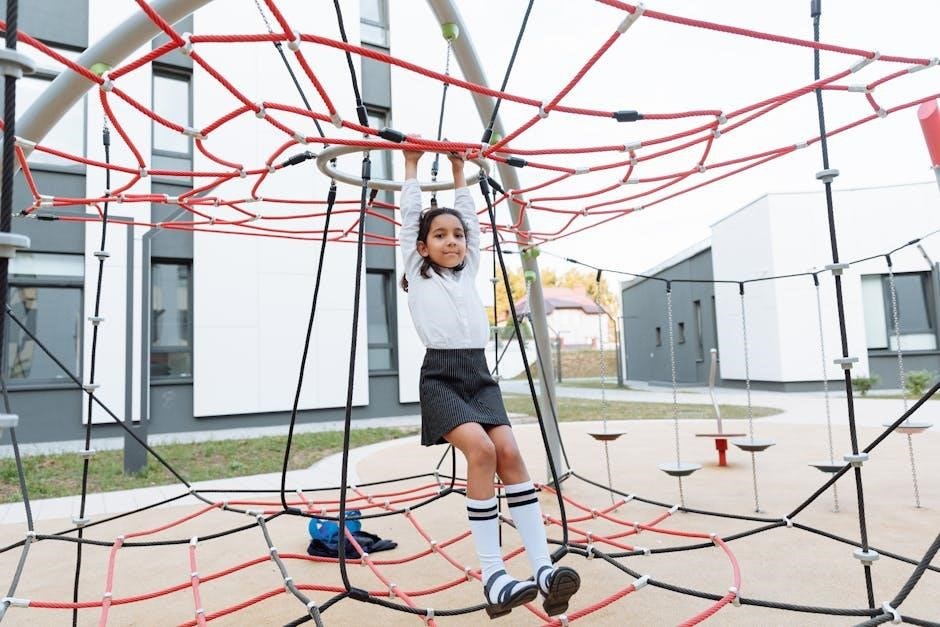
Ball games are an excellent way to enhance motor skills in 3-5 year olds. Activities like rolling, tossing, and catching improve hand-eye coordination and strength. Simple games such as kicking a ball or throwing into a target refine balance and accuracy. Using soft, lightweight balls ensures safety during play. These exercises promote active engagement and prepare children for team-based activities later in life. Supervised practice helps build confidence and fine-tunes motor abilities, making ball games a fun and effective tool for physical development. Regular play fosters skill mastery and creativity in movement.
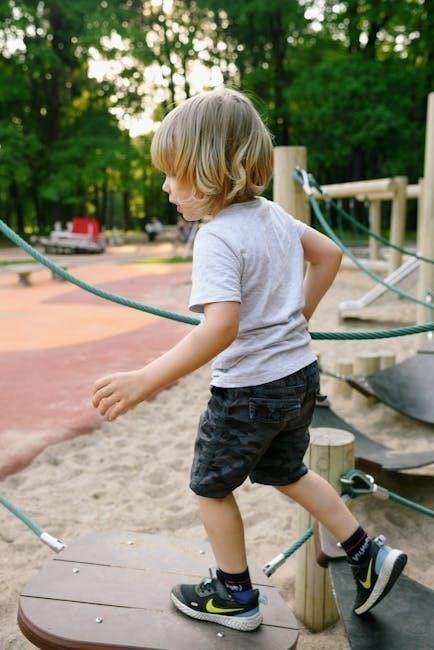
Fine Motor Skills Development
Fine motor skills in 3-5 year olds are refined through activities like drawing, cutting, and puzzles, enhancing hand-eye coordination, dexterity, and creativity. Playful tasks foster precision and control, preparing children for complex tasks like writing and problem-solving. Regular practice with small objects and tools strengthens finger muscles, promoting independence and confidence in daily activities. These exercises are crucial for overall cognitive and physical growth, laying a strong foundation for future academic and practical skills. Consistent engagement ensures steady progress and mastery of intricate movements. Fun and repetitive exercises make learning enjoyable and effective. Outdoor activities like using ribbons or bubbles add variety, encouraging creativity while developing motor abilities. Structured playtime with age-appropriate materials ensures safety and engagement, allowing children to explore and learn at their own pace. Supervision and guidance from caregivers help children refine their skills and build a lifelong love for active learning. Regular assessment of progress helps tailor activities to individual needs, ensuring each child reaches their full potential. With patience and encouragement, children develop the fine motor skills essential for success in school and beyond. By incorporating music and rhythms, activities become more engaging, making the learning process enjoyable and dynamic. Ensuring a variety of tasks keeps children interested and motivated, fostering a well-rounded development. Safety remains a priority, with soft surfaces and appropriate equipment minimizing risks during play. Evaluating effectiveness through observation and feedback allows caregivers to adjust activities, ensuring they meet each child’s unique needs. In conclusion, fine motor skills development is a vital part of early childhood education, requiring consistent, creative, and safe practices. Encouraging a love for physical activity from an early age sets the stage for a healthy, active lifestyle. Final tips for parents include providing ample opportunities for play, using household items for activities, and celebrating small achievements to boost confidence. By following these guidelines, caregivers can effectively support the physical development of 3-5 year olds, helping them thrive in all areas of growth.
Hand-Eye Coordination Activities
Activities enhancing hand-eye coordination for 3-5 year olds include tossing balls, catching, and throwing. Using props like ribbons, bubbles, or balloons encourages tracking and movement. Simple games like hitting a balloon with a paddle or rolling a ball into a target refine timing and dexterity. These exercises improve precision, reaction time, and overall motor control, preparing children for more complex tasks. Regular practice fosters confidence and skill mastery, laying a strong foundation for sports and daily activities. Incorporating music or themed play makes these exercises engaging and fun. Supervised outdoor adventures further enhance coordination in natural settings. Age-appropriate equipment ensures safety and suitability for developing abilities. Evaluating progress through observation helps adjust activities to meet individual needs, ensuring each child progresses effectively. Combining creativity with structured playtime keeps children motivated and eager to learn. Safety measures, like soft landing surfaces, allow for worry-free practice. In conclusion, hand-eye coordination activities are vital for early development, promoting physical and cognitive growth. Encouraging active participation and celebrating small achievements fosters a lifelong love for physical activity. Providing varied and engaging tasks ensures well-rounded development, setting the stage for future success. Caregivers play a crucial role in modeling these activities, making them enjoyable and educational for young children. With consistent practice and positive reinforcement, children build essential skills that benefit them throughout their lives. Parents and caregivers should prioritize these activities, creating a supportive environment that encourages learning and growth. By doing so, they help children develop the coordination and confidence needed for a variety of challenges. Effective planning and supervision ensure that activities are both safe and beneficial, making every moment an opportunity for development. Ultimately, hand-eye coordination activities are a cornerstone of early childhood physical development, offering countless benefits for young learners.
Drawing, Coloring, and Cutting Tasks
Drawing, coloring, and cutting are excellent fine motor activities for 3-5 year olds, enhancing hand-eye coordination and dexterity. Using crayons, markers, or colored pencils encourages creativity, while scissors help refine cutting skills. Simple shapes and patterns provide a foundation for precision. Supervised use of child-safe tools fosters independence and confidence. These tasks also promote patience and focus, preparing children for writing and crafting. Regular practice supports the development of essential motor skills, helping children master intricate movements. Creative expression through art builds self-esteem and imagination. Parents and caregivers should encourage daily practice, offering guidance and celebrating progress. Structured yet fun activities ensure steady improvement, laying a strong foundation for future academic and creative endeavors. By incorporating these tasks into routines, children develop the fine motor control necessary for various activities. Safety is key, so ensure age-appropriate tools are used, and adult supervision is provided to prevent accidents. Over time, these activities help children achieve key developmental milestones, preparing them for more complex tasks. Engaging in art fosters a sense of accomplishment and joy, making learning a positive experience. Regular practice strengthens hand muscles, improving overall dexterity and coordination. These activities are not only educational but also a source of enjoyment, encouraging a lifelong appreciation for creative expression. With consistent effort, children gain the skills and confidence needed for future success. Parents and caregivers play a vital role in nurturing these abilities, providing support and encouragement every step of the way. By making these tasks a part of daily routines, they contribute to a child’s overall physical and emotional well-being. This structured approach ensures that children develop at their own pace, building a solid foundation for their future. Through drawing, coloring, and cutting, children explore their creativity while refining essential motor skills, setting them up for success in school and beyond. Regular practice reinforces these skills, helping children meet developmental milestones with ease. Encouraging creativity and providing the right tools empowers children to express themselves effectively, fostering a sense of pride and accomplishment. These activities are a cornerstone of early childhood development, offering countless benefits for physical and cognitive growth. By prioritizing drawing, coloring, and cutting tasks, parents and caregivers help children build the skills they need for a bright and creative future. With patience and support, children can master these tasks, gaining confidence and independence along the way. Incorporating music or themed activities adds an extra layer of engagement, making learning fun and dynamic. Safety considerations, such as using blunt-tipped scissors, ensure that children can practice without risk. Evaluating progress through observation helps tailor activities to individual needs, ensuring each child thrives. In conclusion, drawing, coloring, and cutting tasks are essential for fine motor development, creativity, and emotional well-being in 3-5 year olds. They provide a fun and effective way to support early childhood development, preparing children for future challenges. Parents and caregivers should embrace these activities, creating a supportive environment that fosters growth and creativity. By doing so, they help children develop the skills and confidence needed for lifelong success. These activities are a valuable tool in promoting physical and cognitive development, offering countless benefits for young learners. With consistent practice and positive reinforcement, children can achieve their full potential, setting the stage for a bright and creative future. Parents and caregivers play a crucial role in nurturing these abilities, providing support and encouragement every step of the way. By making these tasks a part of daily routines, they contribute to a child’s overall physical and emotional well-being. This structured approach ensures that children develop at their own pace, building a solid foundation for their future. Through drawing, coloring, and cutting, children explore their creativity while refining essential motor skills, setting them up for success in school and beyond. Regular practice reinforces these skills, helping children meet developmental milestones with ease. Encouraging creativity and providing the right tools empowers children to express themselves effectively, fostering a sense of pride and accomplishment. These activities are a cornerstone of early childhood development, offering countless benefits for physical and cognitive growth. By prioritizing drawing, coloring, and cutting tasks, parents and caregivers help children build the skills they need for a bright and creative future. With patience and support, children can master these tasks, gaining confidence and independence along the way. Incorporating music or themed activities adds an extra layer of engagement, making learning fun and dynamic. Safety considerations, such as using blunt-tipped scissors, ensure that children can practice without risk. Evaluating progress through observation helps tailor activities to individual needs, ensuring each child thrives. In conclusion, drawing, coloring, and cutting tasks are essential for fine motor development, creativity, and emotional well-being in 3-5 year olds. They provide a fun and effective way to support early childhood development, preparing children for future challenges. Parents and caregivers should embrace these activities, creating a supportive environment that fosters growth and creativity. By doing so, they help children develop the skills and confidence needed for lifelong success. These activities are a valuable tool in promoting physical and cognitive development, offering countless benefits for young learners. With consistent practice and positive reinforcement, children can achieve their full potential, setting the stage for a bright and creative future. Parents and caregivers play a crucial role in nurturing these abilities, providing support and encouragement every step of the way. By making these tasks a part of daily routines, they contribute to a child’s overall physical and emotional well-being. This structured approach ensures that children develop at their own pace, building a solid foundation for their future. Through drawing, coloring, and cutting, children explore their creativity while refining essential motor skills, setting them up for success in school and beyond. Regular practice reinforces these skills, helping children meet developmental milestones with ease. Encouraging creativity and providing the right tools empowers children to express themselves effectively, fostering a sense of pride and accomplishment. These activities are a cornerstone of early childhood development, offering countless benefits for physical and cognitive growth. By prioritizing drawing, coloring, and cutting tasks, parents and caregivers help children build the skills they need for a bright and creative future. With patience and support, children can master these tasks, gaining confidence and independence along the way. Incorporating music or themed activities adds an extra layer of engagement, making learning fun and dynamic. Safety considerations, such as using blunt-tipped scissors, ensure that children can practice without risk. Evaluating progress through observation helps tailor activities to individual needs, ensuring each child thrives. In conclusion, drawing, coloring, and cutting tasks are essential for fine motor development, creativity, and emotional well-being in 3-5 year olds. They provide a fun and effective way to support early childhood development, preparing children for future challenges. Parents and caregivers should embrace these activities, creating a supportive environment that fosters growth and creativity. By doing so, they help children develop the skills and confidence needed for lifelong success. These activities are a valuable tool in promoting physical and cognitive development, offering countless benefits for young learners. With consistent practice and positive reinforcement, children can achieve their full potential, setting the stage for a bright and creative future. Parents and caregivers play a crucial role in nurturing these abilities, providing support and encouragement every step of the way. By making these tasks a part of daily routines, they contribute to a child’s overall physical and emotional well-being. This structured approach ensures that children develop at their own pace, building a solid foundation for their future. Through drawing, coloring, and cutting, children explore their creativity while refining essential motor skills, setting them up for success in school and beyond. Regular practice reinforces these skills, helping children meet developmental milestones with ease. Encouraging creativity and providing the right tools empowers children to express themselves effectively, fostering a sense of pride and accomplishment. These activities are a cornerstone of early childhood development, offering countless benefits for physical and cognitive growth. By prioritizing drawing, coloring, and cutting tasks, parents and caregivers help children build the skills they need for a bright and creative future. With patience and support, children can master these tasks, gaining confidence and independence along the way. Incorporating music or themed activities adds an extra layer of engagement, making learning fun and dynamic. Safety considerations, such as using blunt-tipped scissors, ensure that children can practice without risk. Evaluating progress through observation helps tailor activities to individual needs, ensuring each child thrives. In conclusion, drawing, coloring, and cutting tasks are essential for fine motor development, creativity, and emotional well-being in 3-5 year olds. They provide a fun and effective way to support early childhood development, preparing children for future challenges. Parents and caregivers should embrace these activities, creating a supportive environment that fosters growth and creativity. By doing so, they help children develop the skills and confidence needed for lifelong success. These activities are a valuable tool in promoting physical and cognitive development, offering countless benefits for
Puzzles and Small Object Manipulation
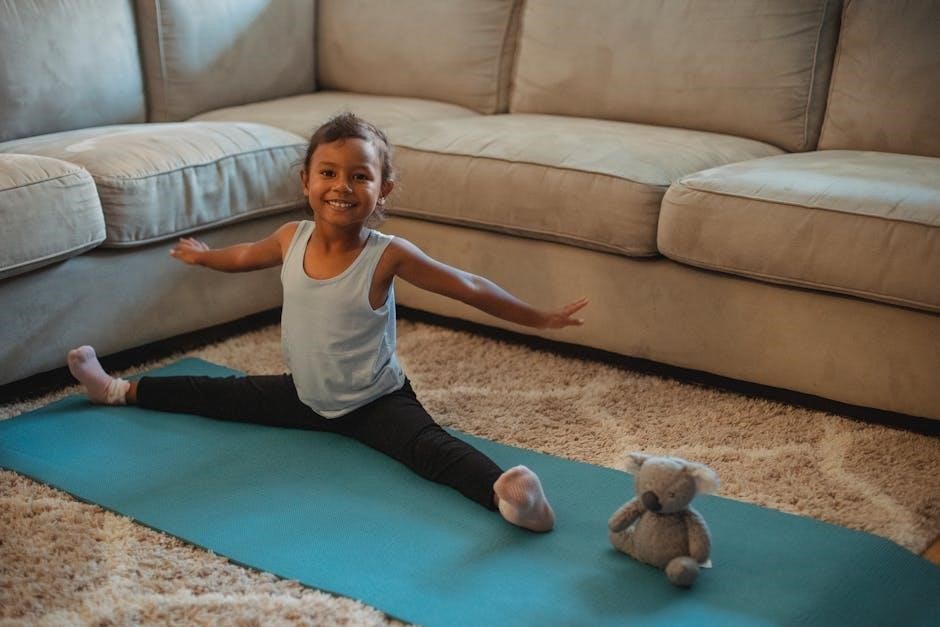
Puzzles and small object manipulation are excellent for refining fine motor skills and hand-eye coordination in 3-5 year olds. Activities like shape sorters, stacking blocks, and using tweezers with small objects enhance dexterity and precision. These tasks encourage problem-solving and patience, fostering creativity and concentration. Simple puzzles help develop critical thinking, while manipulating small objects improves finger strength and control. Parents and caregivers should provide age-appropriate puzzles and small toys, guiding children as needed. Celebrating achievements builds confidence and motivation, promoting a love for learning through play. Regular practice strengthens motor skills and prepares children for more complex tasks. These activities also enhance cognitive development, teaching persistence and logical reasoning. By incorporating puzzles and small object manipulation, parents support physical and cognitive growth, laying a strong foundation for future academic success. Consistent engagement ensures steady progress, helping children master these essential skills. Through these activities, children develop the coordination and precision needed for writing, crafts, and other daily tasks. Encouraging independent problem-solving fosters independence and self-reliance, key traits for lifelong learning. With patience and support, children can overcome challenges, building resilience and a positive attitude toward learning. These activities are a fun and effective way to enhance physical and cognitive abilities, preparing children for the demands of school and beyond. Regular practice ensures steady improvement, helping children achieve their full potential. Parents and caregivers play a vital role in nurturing these skills, providing guidance and encouragement. By making these tasks a part of daily routines, they contribute to a child’s overall development and well-being. Puzzles and small object manipulation are invaluable tools for fostering growth and creativity in early childhood. With consistent effort, children gain the skills and confidence needed for future success. These activities are a cornerstone of early childhood development, offering countless benefits for physical and cognitive growth. By prioritizing puzzles and small object manipulation, parents and caregivers help children build the skills they need for a bright and creative future. With patience and support, children can master these tasks, gaining confidence and independence along the way. Incorporating music or themed activities adds an extra layer of engagement, making learning fun and dynamic. Safety considerations, such as using age-appropriate materials, ensure that children can practice without risk. Evaluating progress through observation helps tailor activities to individual needs, ensuring each child thrives. In conclusion, puzzles and small object manipulation are essential for fine motor development, problem-solving, and creativity in 3-5 year olds. They provide a fun and effective way to support early childhood development, preparing children for future challenges. Parents and caregivers should embrace these activities, creating a supportive environment that fosters growth and creativity. By doing so, they help children develop the skills and confidence needed for lifelong success. These activities are a valuable tool in promoting physical and cognitive development, offering countless benefits for young learners. With consistent practice and positive reinforcement, children can achieve their full potential, setting the stage for a bright and creative future. Parents and caregivers play a crucial role in nurturing these abilities, providing support and encouragement every step of the way. By making these tasks a part of daily routines, they contribute to a child’s overall physical and emotional well-being. This structured approach ensures that children develop at their own pace, building a solid foundation for their future. Through puzzles and small object manipulation, children explore their creativity while refining essential motor skills, setting them up for success in school and beyond. Regular practice reinforces these skills, helping children meet developmental milestones with ease. Encouraging creativity and providing the right tools empowers children to express themselves effectively, fostering a sense of pride and accomplishment. These activities are a cornerstone of early childhood development, offering countless benefits for physical and cognitive growth. By prioritizing puzzles and small object manipulation, parents and caregivers help children build the skills they need for a bright and creative future. With patience and support, children can master these tasks, gaining confidence and independence along the way. Incorporating music or themed activities adds an extra layer of engagement, making learning fun and dynamic. Safety considerations, such as using blunt-tipped scissors, ensure that children can practice without risk. Evaluating progress through observation helps tailor activities to individual needs, ensuring each child thrives. In conclusion, puzzles and small object manipulation are essential for fine motor development, creativity, and emotional well-being in 3-5 year olds. They provide a fun and effective way to support early childhood development, preparing children for future challenges. Parents and caregivers should embrace these activities, creating a supportive environment that fosters growth and creativity. By doing so, they help children develop the skills and confidence needed for lifelong success. These activities are a valuable tool in promoting physical and cognitive development, offering countless benefits for young learners. With consistent practice and positive reinforcement, children can achieve their full potential, setting the stage for a bright and creative future. Parents and caregivers play a crucial role in nurturing these abilities, providing support and encouragement every step of the way. By making these tasks a part of daily routines, they contribute to a child’s overall physical and emotional well-being. This structured approach ensures that children develop at their own pace, building a solid foundation for their future. Through puzzles and small object manipulation, children explore their creativity while refining essential motor skills, setting them up for success in school and beyond. Regular practice reinforces these skills, helping children meet developmental milestones with ease. Encouraging creativity and providing the right tools empowers children to express themselves effectively, fostering a sense of pride and accomplishment. These activities are a cornerstone of early childhood development, offering countless benefits for physical and cognitive growth. By prioritizing puzzles and small object manipulation, parents and caregivers help children build the skills they need for a bright and creative future. With patience and support, children can master these tasks, gaining confidence and independence along the way. Incorporating music or themed activities adds an extra layer of engagement, making learning fun and dynamic. Safety considerations, such as using blunt-tipped scissors, ensure that children can practice without risk. Evaluating progress through observation helps tailor activities to individual needs, ensuring each child thrives. In conclusion, puzzles and small object manipulation are essential for fine motor development, creativity, and emotional well-being in 3-5 year olds. They provide a fun and effective way to support early childhood development, preparing children for future challenges. Parents and caregivers should embrace these activities, creating a supportive environment that fosters growth and creativity. By doing so, they help children develop the skills and confidence needed for lifelong success. These activities are a valuable tool in promoting physical and cognitive development, offering countless benefits for young learners. With consistent practice and positive reinforcement, children can achieve their full potential, setting the stage for a bright and creative future. Parents and caregivers play a crucial role in nurturing these abilities, providing support and encouragement every step of the way. By making these tasks a part of daily routines, they contribute to a child’s overall physical and emotional well-being. This structured approach ensures that children develop at their own pace, building a solid foundation for their future. Through puzzles and small object manipulation, children explore their creativity while refining essential motor skills, setting them up for success in school and beyond. Regular practice reinforces these skills, helping children meet developmental milestones with ease. Encouraging creativity and providing the right tools empowers children to express themselves effectively, fostering a sense of pride and accomplishment. These activities are a cornerstone of early childhood development, offering countless benefits for physical and cognitive growth. By prioritizing puzzles and small object manipulation, parents and caregivers help children build the skills they need for a bright and creative future. With patience and support, children can master these tasks, gaining confidence and independence along the way. Incorporating music or themed activities adds an extra layer of engagement, making learning fun and dynamic. Safety considerations, such as using blunt-tipped scissors, ensure that children can practice without risk. Evaluating progress through observation helps tailor activities to individual needs, ensuring each child thrives. In conclusion, puzzles and small object manipulation are essential for fine motor development, creativity, and emotional well-being in 3-5 year olds. They provide a fun and effective way to support
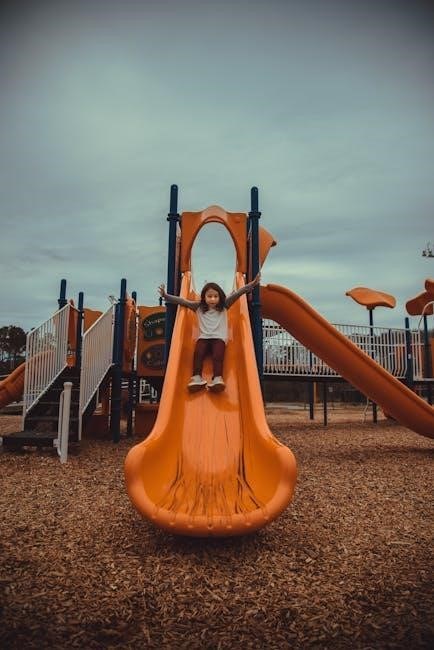
Indoor Physical Activities
Indoor physical activities for 3-5 year olds include dance parties, obstacle courses, and balancing games, promoting gross motor skills, coordination, and creativity in limited spaces.
Dance Parties and Movement Games
Dance parties and movement games are engaging indoor activities for 3-5 year olds, fostering gross motor skills, coordination, and creativity. Play upbeat music and encourage children to dance freely, exploring movements like twirling, jumping, and clapping. Incorporate simple props like ribbons or balloons for added fun. These activities enhance rhythm, balance, and physical endurance. Parents can organize themed dance sessions or follow movement instructions, making it an interactive and enjoyable way to promote physical development while boosting social interactions and emotional well-being in a safe, controlled environment.
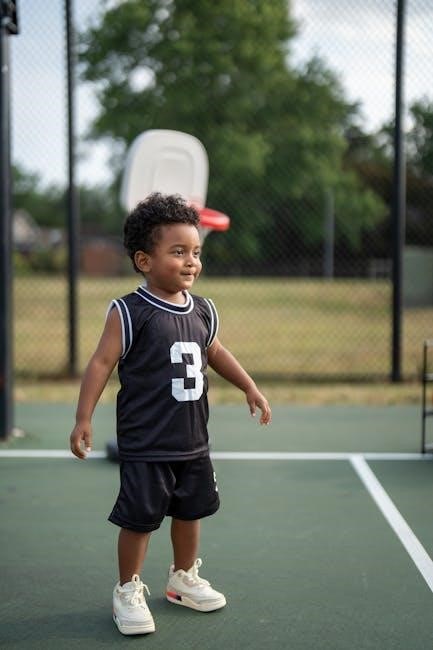
Obstacle Courses in Limited Spaces
Obstacle courses are versatile indoor activities that promote gross motor skills and creativity in 3-5 year olds. Using household items like cushions, chairs, and blankets, create a simple course with challenges like crawling, climbing, or balancing. These activities enhance coordination, strength, and problem-solving abilities while adapting to small spaces. Kids can navigate around furniture, step over lines, or crawl through tunnels, making it a fun way to stay active indoors. This engaging play fosters physical development and imagination, ensuring children remain entertained and active even in confined areas.
Balancing and Crawling Activities
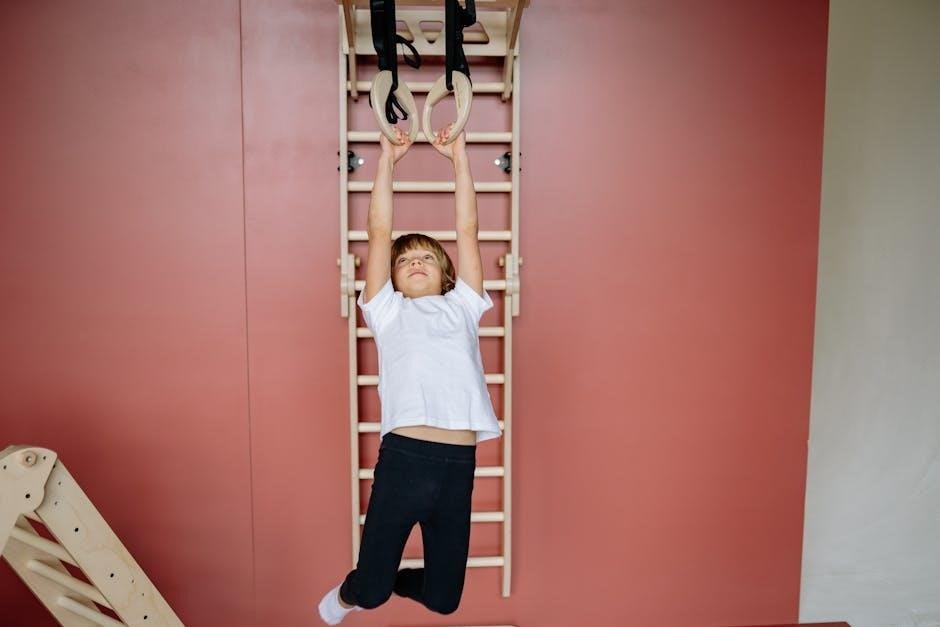
Balancing and crawling activities are fundamental for refining motor skills in 3-5 year olds. Create a mini balance beam using a line on the floor or a low bench. Encourage walking along it with arms outstretched. Crawling through tunnels or over cushions enhances flexibility and coordination. For added challenge, incorporate props like ribbons to follow while balancing. These activities strengthen core stability, improve posture, and boost overall physical confidence in a playful and engaging manner, suitable for both indoor and limited spaces. They also adapt to varying skill levels, ensuring every child can participate and progress.
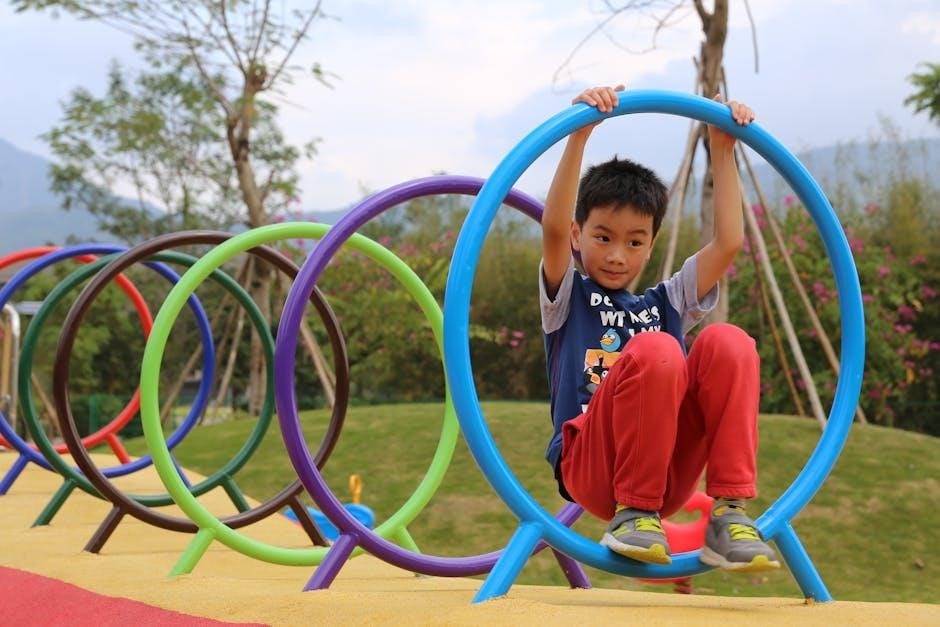
Outdoor Physical Activities
Outdoor physical activities for 3-5 year olds include tag games, races, cycling, and exploring nature, which enhance motor skills and foster a love for active exploration.
Tag Games and Races
Tag games and races are excellent outdoor activities for 3-5 year olds, promoting gross motor skills like running, agility, and endurance. These activities encourage teamwork, social interaction, and healthy competition. Simple games like classic tag or relay races help improve speed and coordination. They also foster emotional well-being by teaching children to win gracefully and persevere. Adapt these games to suit the age and ability of the child, ensuring everyone can participate and enjoy the fun. Such activities are perfect for developing physical fitness while fostering creativity and joy in movement.
Cycling, Scooting, and Skating
Cycling, scooting, and skating are fantastic outdoor activities that enhance gross motor skills, balance, and coordination in 3-5 year olds. These activities help children refine their ability to control movement and maintain equilibrium. Age-appropriate bikes, scooters, or skates with safety gear are essential. Supervise children to ensure they learn proper techniques and safety precautions. These activities also foster independence, endurance, and confidence. Incorporate fun challenges, like obstacle courses or themed rides, to keep children engaged and excited about physical movement while developing essential motor skills in a playful way.
